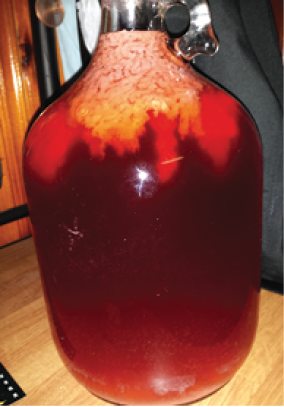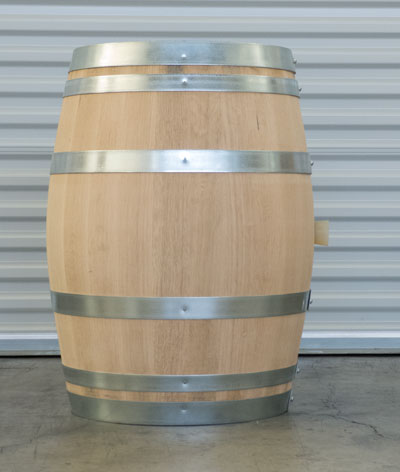Q
Looking at the photo of my strawberry wine (see image) I currently am fermenting, I am wondering what is this brain-looking thing floating at the top of my wine? It’s still bubbling like crazy, is this OK and normal? It’s made from fresh fruit, not a kit. It is clearing well and the smell is good. Please help, I’m new at this and it’s my first fresh fruit wine batch.
Tiffany Blickhan
La Grange, Missouri
A
I just saw your picture and wow, that does indeed look like a floating brain — or two! Luckily, that is a great shot of what I would call typical “fruit floaties” combined with some of the fruit’s natural pectin, and I don’t think it’s anything to worry about. You see, when you make wine with fresh fruit, even if you use a press and maybe a cheesecloth strainer, little particles of the fruit will still get through into your fermenter and will usually float to the top during active fermentation. I actually made a fresh strawberry puree the other day and passed it through a strainer into my saucepan. As the juice heated up, I saw lots of little air bubbles and tiny white particles from the fruit pulp float up to the surface of my pot. I think you’re seeing the same thing happening in your carboy.
Strawberries are also naturally high in pectin, and when doing strawberry wine I always recommend using a pectic enzyme to help break those pectins down (follow instructions on the package since products can be different). The pectic enzyme can be added in the fruit stage to help release more juice before pressing, and it can also be used in finished wine to help clear it. You can purchase powdered or liquid pectic enzyme from most home winemaking and brewing supply stores. It’s important to follow the package directions to the letter and measure carefully, because too little won’t be effective at clearing the wine and you don’t want residual enzyme in your wine that you don’t need.
When it comes time to physically rack, if you still have floaty bits you’d rather avoid, a little trick I use is what I call “subsurface” racking, where you put your thumb over the end of the racking wand or siphon hose as you push the hose through the surface of your floating layer, to make sure none of the floating bits get into your racking hose. Once the end of the hose or tube is in the clear, get your siphon going and rack away, being careful to stop once solids are reached either on the top or the bottom. If you still have a lot of sedi-ment that has trapped much of your wine, you can always carefully pour these through multiple layers of cheesecloth in an effort to strain out what liquid you can.
Since you report the wine smells good, is clearing well and is fermenting away, I wouldn’t worry about your floating science experiment. Strawberries make lovely wine and in spite of their natural pectin content, tend to be a fairly forgiving fruit for your first time around. The color certainly looks nice and as long as things keep fermenting along fine, you should be on your way to making some beautiful strawberry wine.
Q
I have done malolactic fermentation (MLF) on several wines and know that adding potassium sorbate to the wine can cause an incurable fault of geranium smelling wine. I have some wines that have gone through MLF and could benefit from being just a bit sweeter — one being an apple wine. I do not have the capability to sterile filter. Is there a way to make these sweeter and be assured that I won’t get refermentation?
Craig Mason
St. Peters, Missouri
A
Unfortunately, there are only so many options for preventing fermentation in sweet wines and they all involve some degree of sacrifice or difficulty. The list of “cons” is long compared with the one “pro” of an arrested fermentation. First off, you’re correct that adding sorbate can sometimes produce off-flavors over time. Secondly, fortifying with alcohol to a point high enough to retard refermentation (usually around 18% alcohol) is not ideal for all winemaking style goals; you’d be better off aiming to make a Port-style wine in the first place. Thirdly, it’s impossible to add enough sulfur dioxide to ward off fermen-tation without compromising aroma. Who wants to drink a wine that smells and tastes like sulfur dioxide? And finally, filtration is fiddly and, if you have to buy or rent the filter, can be expensive.
So what’s a winemaker to do? Depending on the volume, and especially if you have access to a second fridge in your house or cellar, did you think about sweetening it and then chilling it? I’m thinking, especially if you saved it for a major celebration or holiday where you and your guests might conceivably go through a whole carboy (or two?) within a month or so, you might be better off to sweeten it, chill it, store it and drink it all without going to the bottle at all.
Barring that crazy thought, I think you should give potassium sorbate a try as it seems to be the least onerous of the options. You may get lucky and perhaps won’t experience much of the “sorbate off-aroma” that can smell like geranium. Unfortunately, you really can’t do bench trials on 100 mL samples like I usually recommend, because the off-aroma from potassium sorbate happens in the bottle over time as the sorbate is broken down into ethyl sorbate. However, you can try to limit the amount you put in. What’s nice is that the higher your alcohol, the less you have to use. For a wine that’s 12% ethanol, a recommended dose is 100 mg/L, while 10% alcohol wine needs 150 mg/L. Adjust accordingly. The silver lining here is that the off-aroma may not develop, or that the fruit quality of your wine may be able to tolerate it well. Other than turning your wine into a fortified product, or filtering, I think that’s perhaps your best avenue.
Q
I would like to sweeten some red wine that has gone through MLF. I know that I need to prevent renewed fermentation. Will sulfite prevent renewed fermentation? If so, what concentration of free sulfur do I need?
Greg Farke
Armour, South Dakota
A
It seems that you and Craig are going through many of the same issues (see the previous question and answer). Like I mentioned to Craig, it’s really impossible to add enough sulfur dioxide to retard a yeast fermentation because, contrary to popular belief, yeast just aren’t that sensitive to SO2. Unlike bacteria, yeast can still have a wide range of activity at high levels (even above 50 ppm FSO2) in juices and wines. Depending on your sensitivity, you may start to smell the FSO2 at levels of 30 ppm and above. Don’t forget that even a small amount of carbon dioxide, like that produced by a partially-viable yeast cell, will amount to a “flaw” or defect in your still red wine.
I am a proponent of sterile filtration if you can rent one from a winemaking supply store or share the cost of one with some winemaking buddies. If you want to get beyond making wines that are “primary fermentation dry” it might be a piece of equipment you should budget for. Barring that, I really think adding sorbate might be your only option. Yes, there is a chance of developing a geranium off-odor, but some people don’t think that’s the end of the world. If your alcohol is 12%, you will add 100 mg/L potassium sorbate. If it’s 14% you can get away with 50 mg/L. If you aren’t into dosing with sorbate, you may have to decide if you’d prefer a sparkling red sweet wine.
Q
I screwed up my wine pretty badly by adding 3 tsp of potassium metabisulfite to 3 gallons (11 L) of Concord and the same to my Niagara. I had my wine tested by a local lab and they alerted me to the fact that my free SO2 was excessively high — 15 and 18 times what it should be. Do you have any recommendations as to how I can fix this? It has been suggested that I agitate it to mix air into the wine. Is the wine salvageable? In the unrealistic event I would be able to get these sulfites down to acceptable levels, do you think that this type of constant agitation would alter the flavor of the wine?
Jared Hermany
Allentown, Pennsylvania
A
Oh boy, oh boy, oh boy. Sounds like you have a lot of sulfur dioxide in that wine! Assuming standard FSO2 for bottled wine being around 25 ppm, am I correct in interpreting 15-18 times higher “than what it should be” to be around 375 ppm FSO2? If that’s the case, I think you are way too high to “wait it out” or to try to agitate the wine in hopes of oxidizing it. I really think your only hope, and it’s a slim one since the remedy might be worse than the disease, is to use hydrogen peroxide to try to remove it.
Hydrogen peroxide (yes, the 3% stuff you can buy at the pharmacy) is a very strong oxidizer. In fact, at high concentrations (not available at the pharmacy) it’s such an “instant” oxidizer that it is used as a propellant in rocketry! Even if you’re using the “diluted stuff” it’s still important to treat it with respect and to mix it carefully into wine. Because sulfur dioxide is so easily-oxidizable, hydrogen peroxide naturally “finds” the easily-oxidized SO2 and the two hopefully cancel each other out. You have to measure your volumes extremely carefully, however, because if there’s any un-oxidized hydrogen peroxide, it will go for all the other goodies in your wine, probably darkening the color and perhaps permanently changing flavors. I offer the following procedure as a last-ditch effort to save this batch of wine.
Before you start, it’s critical you know what your beginning SO2 concentration is. You do not want to add more hydrogen peroxide than you absolutely have to. If you’re at all doubtful about your own lab skills or worry about your reagents being a little out of date, it’s best to send a sample to a professional wine lab. After you get your result in ppm FSO2, calculate how much hydrogen peroxide you will need. To remove 10 ppm SO2 in 1 gallon (3.8 L) of wine, you will need to add 3.5 mL hydrogen peroxide. Use a brand new bottle, making sure to check the expiration date. Measure very carefully using a finely-graduated pipette (10 mL or 5 mL) to be sure you’re not adding too much. Stir gently into your wine. The reaction should take place relatively quickly but it’s best to wait 24 hours before sampling your wine again to re-check the new level of sulfur dioxide.
For more on this topic check out “Wine Kit First Aid” by Tim Vander-grift in the December 2002-January 2003 issue of WineMaker. In the future, I’d also advise that you take advantage of the sulfite calculator on WineMaker ’s website at www.winemakermag.com/sulfitecalculator.
Q
I wanted to ask what your thoughts are on hybrids in Utah. I’m on my second year with Baco Noir and Seyval Blanc. Growing season here is plenty long, but summers are very warm. I won’t have a harvest this year but will the next. I also have five-year-old Pinot Gris vines that I made wine from last year.
Marty Beattie
Riverton, Utah
A
Good for you for planting a nice selection of grapes! You’re absolutely right, that with Utah’s higher latitude, often-high altitude, and warmer summers, you get a bit more extreme growing season than many of us in the rest of the country. For you, winterkill is a real issue, so frost and cold hardiness is essential. This is where hybrid grapes, which are crosses between hardier “American” species (v. Labrusca or v. Rotundifolia) and the typical “European” grapes we associate with fine winemaking, come into play. Hybrids help bridge the gap between flavor, style, and weather tolerance, often making very pleasant wines. Seyval Blanc and Baco Noir are two nice choices and they should give you some good raw material for wines.
Since you’ve decided to try your hand at a European varietal, you actually did choose one that I recommend for places like New Mexico or Utah that have warm summers, higher altitudes, and colder winters. Pinot Grigio doesn’t need as long to ripen as some white wine grapes and higher acid can actually be of benefit in the final wine style. Sauvignon Blanc and Chardonnay are other good choices, and Grenache, Cinsault or even Pinot Noir can sometimes do well for reds.
Because of Utah’s “dry” history (with alcohol I mean, not with the weather), there are perhaps fewer resources for the home viticulturist and home winemaker than other states have. However, it still might be worth your while to contact the Utah State University Extension (extension.usu.edu) to see if they have anybody over there in the agricultural division that could help you out.






